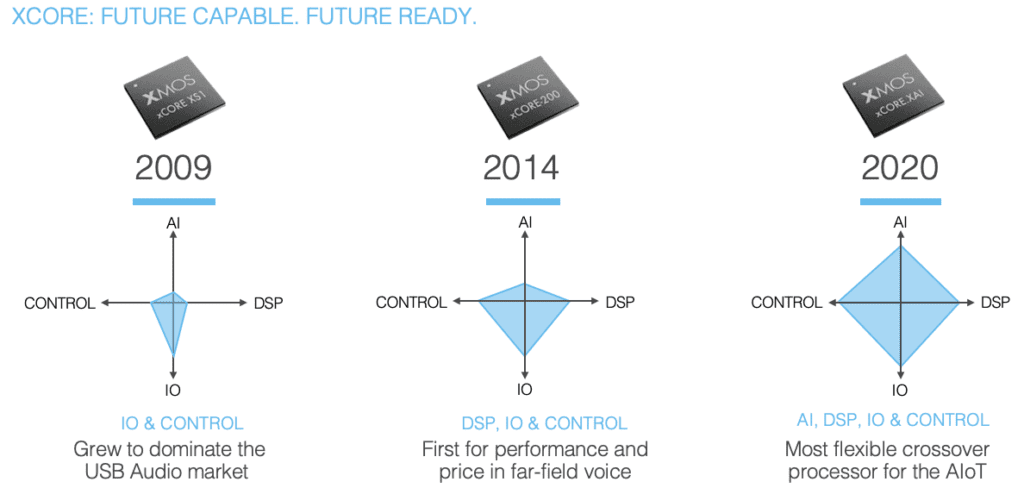The IoT describes connected “things” – a diverse range of “things” that have an internet connection and can be controlled and/or interrogated from anywhere on the web. They can be anything from toys to industrial robots, from cars to rice cookers. Going forward, the application of machine learning to the data inputs from connected devices takes us into the Artificial Intelligence of Things: where data is given context and the end user experience is elevated into a natural, seamless interaction with technology. Catering for such a wide range of product requirements is a growing challenge for the semiconductor industry.
Historically the semiconductor business has been defined and driven by a series of dominant sectors – from defence applications in the 70s, to enterprise applications in the 80s and early 90s. By the millennium, the consumer device sector had exploded into life. Even then, the feature-sets and roadmaps for each sector were relatively predictable, enabling vendors to build a series of highly optimised solutions.
However, the rise of the IoT and emergence of the AIoT has led us to an inflection point. The semiconductor industry is faced with a new set of problems and opportunities – and the strategies that drove success in the past, may not be the ones to drive the winners of the future. John Ciacchella (Semiconductor Practice Strategy Leader, Deloitte Consulting LLP) captures it well:
“The winners can’t just hitch their wagon to new dominant applications and markets, instead they need to be diverse in their application focus and, perhaps most importantly, versatile. This need for product diversity and versatility creates a new challenge for the traditional semiconductor companies. When there is one big market, it is easier to focus efforts – R&D, technology, IP, products, sales and marketing. Instead of focussing on a single market, now companies will likely have multiple medium sized markets to understand. If you then compound this market fragmentation with Moore’s law, the increasing cost of innovation, you may face enormous investment cost if you want to innovate across multiple chip applications.”
He encapsulates some key themes here. The first is diversity – huge though the AIoT “market” is – forecast at 65 billion devices by 2025[1] – it’s actually the sum of “multiple medium sized markets” with differing requirements. Companies are going to have to understand more markets and adapt significantly to fit their needs. This leads us nicely into the second theme which is the need for versatility in products, technology, and operations: to be both nimble and fast in identifying and meeting new demand. Finally, there is the ever-present cost challenge. Customers are putting chip companies under significant downward cost pressure and yet the investment required to innovate and succeed in semiconductors remains enormous. Many special-purpose silicon accelerators are appearing on the market but what’s really needed is a low-cost, versatile, single-chip solution.
The problem with chips
In the semiconductor industry, product cycle times are measured in years not weeks. Yet the diversity and rate of change in the IoT market suggests that we must engage early and adapt rapidly as our customers’ requirements change.
Traditionally, enterprise software companies have built competitive advantage through early engagement, launching “minimum viable products” and using feedback to continually refine the solution. Reid Hoffman (Founder of LinkedIn) famously said:
“If you are not embarrassed by the first version of your product, you’ve launched too late.”By joining your customer’s journey at an early stage, you become more intimate with their needs and build something that delivers real product/market fit. That’s certainly our experience, however, it’s challenging to apply this thinking to semiconductor development. In our industry the quote would more likely be:
“If you are embarrassed by the first version of your product, go home.”
If a semiconductor business gets it wrong and scores a miss on product/market fit, their customer(s) won’t – can’t – wait months or years for a new version. They’ll simply switch supplier. For a semiconductor company in a rapidly evolving market like the IoT, it’s becoming increasingly risky to place bets on hitting a moving target with today’s inflexible architectures, and their lengthy development cycles.
The IoT is changing the shape of the world around us, and we must adjust our technologies and behaviours accordingly. Despite the additional challenges, the mantras of the enterprise software world will become winning strategies for semiconductor companies – engage early and adapt quickly. Ironically, the most appropriate method to deliver this kind of agility is back in the hands of the software engineer, but it takes a special platform with a flexible, unified programming model:
- where AI, DSP, control and communication capabilities coexist reliably and can be combined to address the needs of the application, both at design-time and in real-time.
- where capabilities are accessible, easily and quickly harnessed by the user and affordable in the scope of the end product.
- where upgrades can be delivered immediately, and the technology quickly deployed into other end product types.
Critically, these same capabilities enable semiconductor vendors both to get closer to individual opportunities and to address multiple markets – spreading the cost of platform innovation across diverse opportunities.
Finding the solution
In the audio market, XMOS grabbed market share and achieved success due to its flexible xcore® architecture. We created a USB UAC2 “chipset” in software at lightning speed – and we were first – by a long way. Not only were we first, but we were better, because our architecture enabled customers to differentiate their products on a hardware level, using software for the first time. Wind the clock forward, and our technology has changed the way that the market competes – customers have embraced the xcore flexibility and delighted us with portfolios of innovative (often class-leading) products from the first two generations of our technology.

We’ve just introduced xcore®.ai – our fast, flexible platform for the AIoT. This single device delivers a flexible, unified programming model, where AI, DSP, control and communication capabilities coexist. Extremely powerful and easily programmable, this crossover processor addresses the challenges of diversity, versatility and cost. It’s accessed with industry standard tools and extensive libraries – including a standard C development flow, TensorFlow lite (or ONNX) and FreeRTOS. For our customers, xcore.ai delivers cost effective integration and differentiation, but to the semiconductor industry, it offers a glimpse into the future.
As to cost – it’s available from $1 …
[1] Gartner 2019
